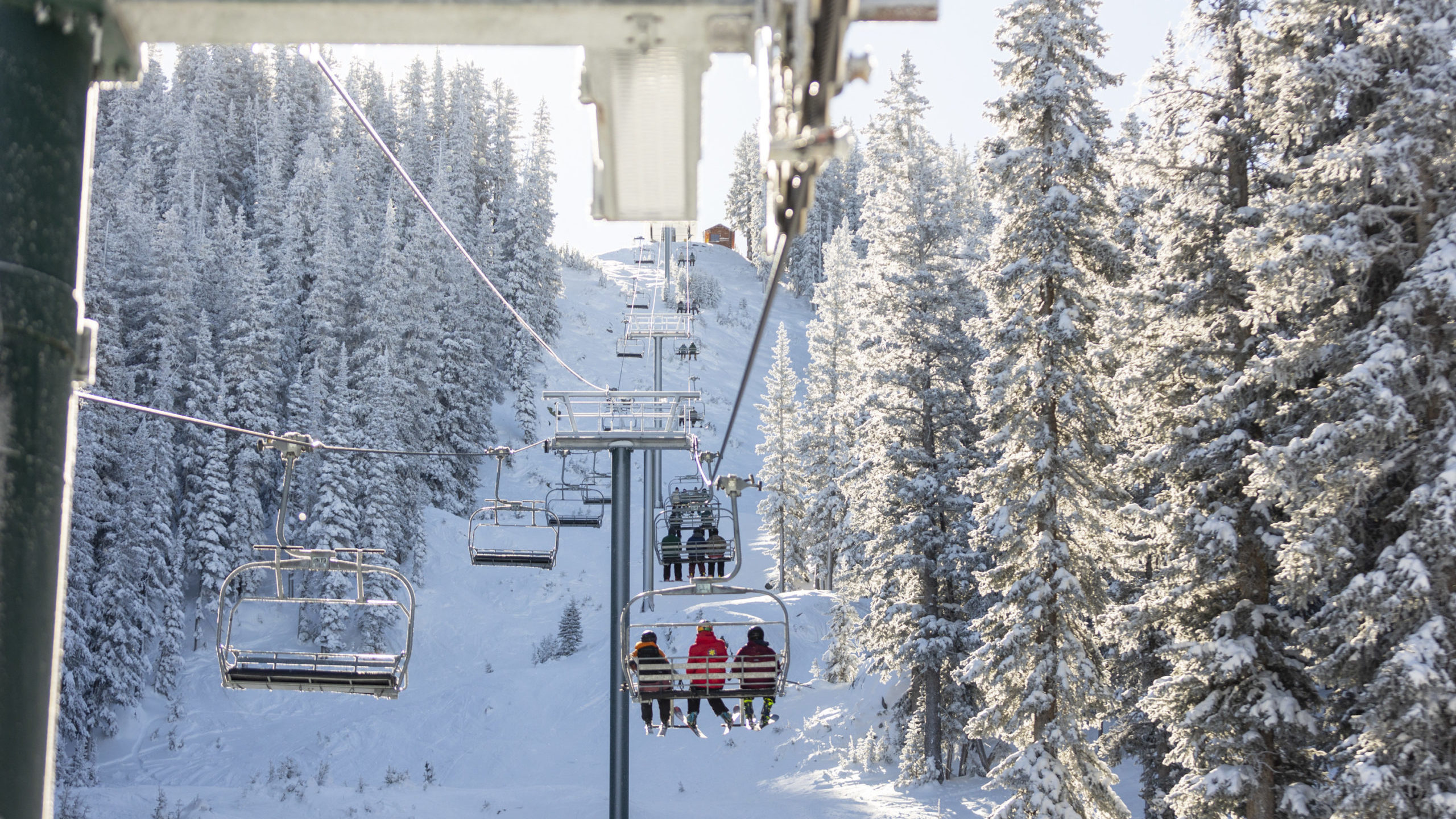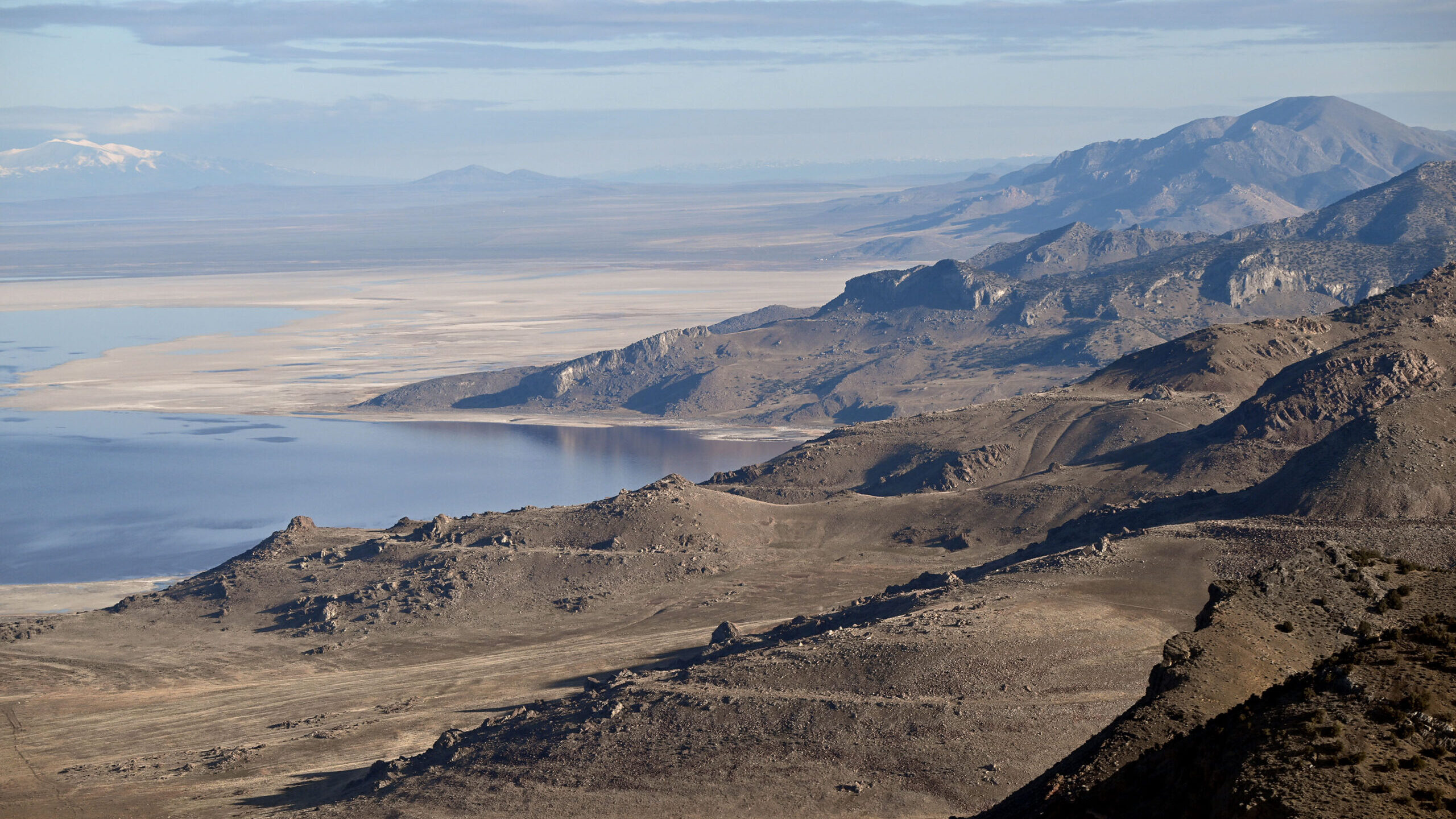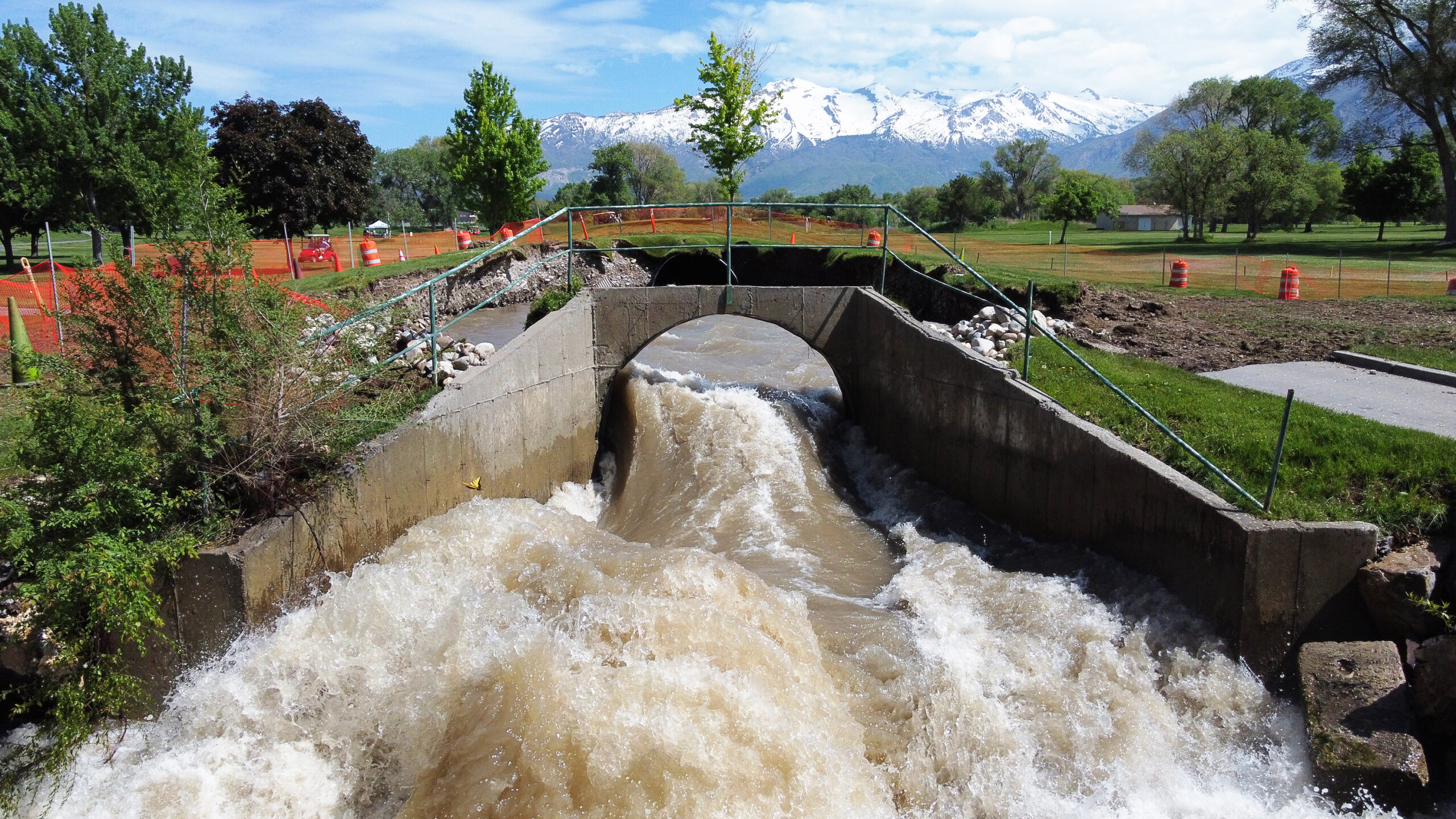Ski resorts raise awareness as Great Salt Lake crisis threatens ‘greatest snow on earth’
Feb 23, 2023, 7:30 AM | Updated: 8:39 am

People ride the lift at Brighton Resort in Big Cottonwood Canyon on Monday, Nov. 14, 2022. (Ben B. Braun/Deseret News)
(Ben B. Braun/Deseret News)
This article is published through the Great Salt Lake Collaborative, a solutions journalism initiative that partners news, education, and media organizations to help inform people about the history and the plight of the Great Salt Lake.
Utah is known for having the “Greatest Snow on Earth.” People flock to Utah’s ski resorts to experience the deep powder that is in part powered by the Great Salt Lake.
However, the drying of Great Salt Lake threatens to compromise the very snow Utah is known for.
A shrinking lake could mean less “lake effect” snow, or what Ski Utah refers to as “mind-numbing powder snow face shots.” And because less water equals more dry lakebed, a smaller lake could also mean earlier snowmelt and affect how long ski resorts can stay open.
What are ski resorts doing to increase sustainability and combat the negative consequences of the shrinking Great Salt Lake?
“We are invested in protecting the Great Salt Lake because the quality of snow in Utah depends on it,” Allison Palmintere, director of communications for Ski Utah, told the Great Salt Lake Collaborative. Ski Utah promotes Utah’s ski and snowbird industry.
While there is no current plan in place that is specifically directed toward the Great Salt Lake, she said the group is focused on combating climate change and supporting sustainability. And she added that the organization consistently meets with legislators and stakeholders to lobby for climate change mitigation.
Sarah Sherman, communications manager for Snowbird, said the Little Cottonwood Canyon resort is assessing to see what it can do for the Great Salt Lake. “We believe in science and numbers,” Sherman said. “We are committed to the local community and environment.”
It recently raised awareness of the lake’s potential demise and its impact on ski resorts by hosting a presentation given by the Nature Conservancy called “Dust on Powder: Saving the Great Salt Lake and the Greatest Snow on Earth.”
“Theoretically, there could be a tipping point at which the lake is too small of a size to create lake effect storms,” warned McKenzie Skiles, a University of Utah professor of geography.
As one of the presenters at Snowbird, she said that a single inch of snowfall is worth $2.8 million in Utah’s $1.6 billion ski tourism industry. If the lake effect diminishes, Utah could lose a significant amount of snowfall, along with the so-called “hype” that the lake effect brings to tourists.
“Everybody loves to talk about this lake effect powder, especially here at Snowbird,” Skiles said. “The lake effect on snow is very important.”
The meteorological phenomenon extends Utah’s ski season by five to seven weeks and is the cause of up to 10 percent of the snow that falls in the Cottonwood canyons, according to the Great Salt Lake Advisory Council.
Those enjoying the slopes know of its importance, too. “The winds blow right across that GSL and pick up all that moisture in the lake and dump it here, and that is why we have the greatest snow on earth and some of the deepest snow in the United States,” said Snowbird skier Mike Adamo when asked about the connection between the lake and the snow.
Powder Mountain in Eden is hosting a similar event this Saturday, Feb. 25, at 5 p.m., with Patrick Belmont, professor of watershed sciences at Utah State University. The discussion will include ideas on what can be done to help maintain ‘the greatest snow on Earth’ through lake restoration.
Belmont said in a phone interview that Utah’s ski industry is in trouble, notwithstanding Wednesday’s monster storm and the record amount of snow that has fallen this year, even as the lake shrinks.
“There is no guarantee,” he said. “There’s no good one or two or three years to solve this problem. Is it wishful thinking that we’re going to even get another year or two of this in the next decade? It might be.”
Belmont said we should be expecting a lot fewer “good snow years.”
“The hotter it gets here, the more snowpack is going to diminish,” he said.
He emphasized just how vital the next few years will be in “turning the corner” on both the lake and climate problem, which he says are “inextricably linked.” And he posed this question to Utahns: “Do we want to start getting up front? Or do we want to keep dragging our feet, pretending climate change isn’t real?”
Belmont told the Great Salt Lake Collaborative the event will cover how the lake got to this crisis-level point, how increasing climate change plays a role in the shrinking of the lake and potential solutions.
“A lot of people are talking about [the lake], but there are a lot of people who don’t quite understand the magnitude of what we’re going to lose,” he said. What matters, he added, is “getting drops of water into the lake” as soon as possible.
Dust on snow
The other significant connection between the Great Salt Lake and Utah’s snowpack is the dust-on-snow phenomenon, which Skiles has studied since its first documented occurrence in 2017.
According to Skiles, her team at the U. found a “distinct brown layer in the snowpack,” which doesn’t typically occur in the Wasatch mountains. Her team found that the dust deposit significantly accelerated snow melt.
“Snow is one of the brightest surfaces on earth… when you deposit contaminants like dust you make it darker. [It’s like] switching from a white T-shirt to a black T-shirt on a sunny day — you get significantly warmer.”
In 2022, Skiles said that all dust — 25 percent of which came from the Great Salt Lake’s dry lakebed — “accelerated snow melt by over two weeks.” It’s a level that she expects to only increase in the future.
Ecological and health impacts
Bonnie Baxter, director of the Great Salt Lake Institute at Westminster College, explained at the Snowbird event how lack of moisture at the lake has effects beyond the snow. It impacts the lake’s basic ecology, the economy and human health. She said the lake is currently at a 19% salinity level, compared to the healthy level of 12%, which she said is “terrifying.” It means the lake’s brine shrimp food chain could collapse, impacting the 10 million birds that feed on the shrimp and brine flies.
The dust will also affect human health because the lakebed contains heavy metals such as mercury and arsenic that will be gradually released into the air.
“Because it’s a terminal lake, it’s holding all the heavy metals it’s ever encountered,” she said, which will have nowhere to go but into the air humans breathe.
Baxter and Skiles emphasized just how important action is in this dire scenario, including both legislative and individual action.
“We as scientists can only do so much by putting our research out there,” Skiles said. “Hearing from constituents is a very important part. When you see [good] legislation coming up, say something. Speak up, say, ‘I support this.’”
Audience reaction
Skier Rebecca Wallace attended the presentation and plans to spread the message. “I’m very concerned about the Great Salt Lake,” she said. “I’m concerned about the wildlife, I’m concerned about the health effects on humans. I’m concerned that this is an ancient lake that may be on its way out.”
She wants to get more involved. “I was getting my teeth worked on the other day and I was telling the dental hygienist about the Great Salt Lake! But the other thing I’m going to do is make the time to write legislators… I want to feel like I’m doing my part,” she said.
Emily Golitzin, who works at Alta Ski Resort, also attended as a concerned citizen and avid skier. “Our jobs kind of depend on the ski industry being successful, also what we do for fun,” she said. “I’m concerned about how long I’ll get to live here. It seems unsustainable at this time.”
What are resorts doing for sustainability
Palmintere said resorts have “robust, holistic sustainability plans” that address climate change and sustainability. She said the ski industry as a whole has been a “canary in a coal mine” as far as climate change goes and that since snow is their best asset, consistent discussions and action planning on sustainability is increasingly important.
The following local resorts have published their sustainability plans, which call for actions like planting trees, eliminating waste and incentivizing green transportation: Alta, Park City, Powder Mountain, Snowbird and Sundance Mountain resort.
In addition, Palmintere said that the larger corporate entities that own much of Utah’s ski resorts, including Vail, Powdr Corporation and Alterra, entered into a Climate Collaborative Charter and have committed to being carbon neutral by 2025.
The most important thing, she said, is “continuing to bring awareness and continuing to stress the importance.”













